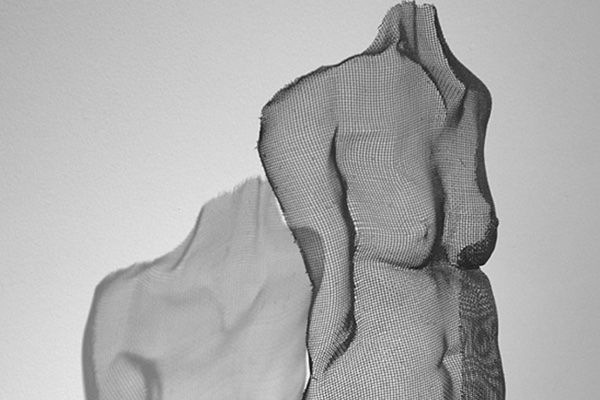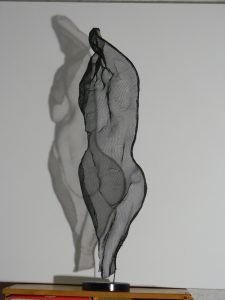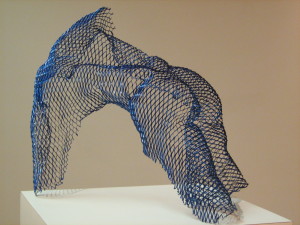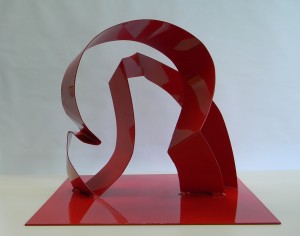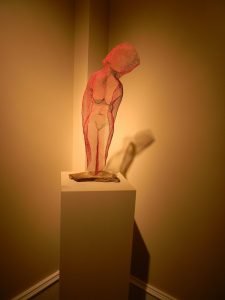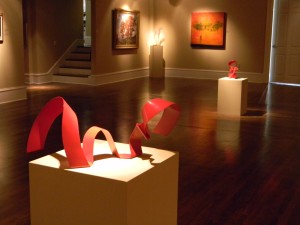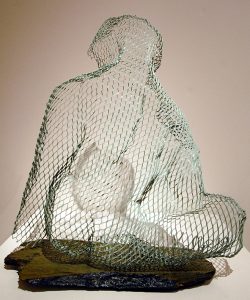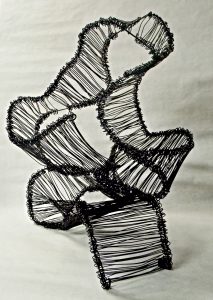Interview of Donald Kolberg by Jung Katz
STEEL MESH AND RIBBON SCULPTOR
September 14, 2015 written by Casey Webb
Tell us about yourself, who are you, where are you from, and what do you do?
I’m a sculptor living in Central Florida, Palm Coast. I experiment with different mediums as I create organic concepts of Life Forms. I graduated in Fine Art from Cal State, Los Angeles and went on to my Masters work at Otis Art Institute. I’ve been a dancer, a freelance photographer, a TV producer for PBS, a hippie at Woodstock (the original), and always, an artist.
How did you get started doing what you do?
I think I’d like to relate this question to what I do now. If what you’re looking for is how I got started in art- well that’s just pretty generic. The work I do now in Steel Mesh came out of something ordinary nearly 20 years ago, fixing a screen door. I was doodling with an extra piece of screen and created a small figure. Up until then I struggled with the way traditional sculpture was about reduction or addition, what we see in bronze, wood, clay and other dense material. Working with this new medium let me concentrate on manipulation. Because of the open mesh, I am able to explore the underlying tension of muscles and movement in relation to the implied mass of the figure. Shadows created by these sculptures appear three dimensional, complementing the original structure of the art. Viewed together, they are a dance of form and movement that has not been seen in traditional carving or modeling. This concept also flowed into the Steel Ribbon sculptures I’ve been creating. Using flat circles of 18 gauge steel I hand form curves into organic figurative forms.
How would you describe your style?
My style is about manipulating and exploring figurative and organic forms. It’s about using different material in unusual ways to create conversations with the viewer. I try to stay away from right angles and move more toward what Matisse called “arabesque”. I am always looking for solutions to the ideas of portraying form and movement.
What’s your inspiration?
My inspiration comes from a number of places. I’m a people watcher, seeing how they react to situations. I’m a listener, hearing what other artists are struggling with or how they overcame an obstacle. And I’m a reader. One of my few disciplines is to spend at least 2 hours reading blogs which lead to articles which lead to investigations of artists I find on the internet. I have a napkin hanging on my wall above my computer that says “Life is turning Coffee into Art”. The meaning of that changes every morning with my first cup of coffee.
What is art to you?
Art for me is about exploration and experimentation. Not just in creating but also in conversations and relationships; when an artist, or actually anyone, drops by the studio they know they are free to pick up pretty much anything laying around and create something. There’s a bunch of us that meet regularly at a local restaurant, not just visual artists, but photographers, crafters, and people not involved with any of the usual arts. We talk about pretty much anything for hours at a time. The take away is the mental stimulation that nourishes the creative process. It’s not rocket science just good people yakking and creating good feelings.
What does your typical day look like?
I get up when I’m done sleeping. And until you’ve lived enough years and had life get in the way of most of what you want to do, you can’t understand that statement. My studio is attached to the house so it’s a short walk through the kitchen for coffee and into the studio. I find that my day revolves around art. Some days mostly hands on, and other days on the computer researching an artist I like or writing articles or poetry. When I’m working in the studio, I tend to work on multiple projects. Working with steel takes its toll so I may leave a piece and spend time threading 6 inch bar ties with cable to get them ready for a new sculpture. Sometimes I’ll be working out a design and it leads to a painting series. Then my time is split between painting and sculpture, not an unhappy situation.
How do you keep motivated?
Motivation is tricky. There are all kinds of clichés covering just about everything you can think of to help you stay motivated. Then there is Chuck Close’s line: “Amateurs look for inspiration; the rest of us just get up and go to work.” I don’t personally know any artist that is so busy selling that they don’t sometimes wonder why they’re doing art. But if you ask them if they are going to stop they’ll tell you, of course not! So it seems that if you’re talking to an artist the issue of motivation is mute, there is always some new thing to do.
What do you hope to accomplish with your work?
I want people to feel they are looking at movement. Not a frozen moment in time but a landscape of human feeling expressed in a pose whether it is figurative or abstract. These are what I call Life Forms.
How have others reacted to your work?
People that know me have come to expect that I continually explore new materials. Yet they also understand that the underlying theme has to do with an organic display of forms. Luckily, my relationships with other artists are honest enough that my friends are not afraid to tell me what they really think about a particular series. I like feedback, and I’m not new at this so my skin is plenty thick.
What do you want others to take away from your work?
I want people who see my work to have a sense that they saw something that wasn’t familiar. That it made them think and that it had enough substance that they would remember it or even tell someone about it. As great as it seems to have all this art out on the internet, standing in front of a piece is a totally different experience.
What, if anything, would you tell your younger self?
I guess I would have to say, “Don’t add up the mistakes!” I know my younger self wouldn’t have had the attention span to listen to any more than that. He’d be too busy chasing the next shiny object.
What’s the best advice you’ve been given?
Do something! And listen to the universe.
Any words of wisdom to aspiring artists who want to pursue a similar career?
Don’t just think about doing projects. If you have to work 50 hours a week part time so you can afford to do art, do it.
What are your thoughts on art school?
It’s always possible to overcome any education. Don’t believe it’s the end-all to success!
What’s your dream project?
I have the designs, mostly in my head, for a series of large organic steel outdoor sculptures. I would love to be able to put that project together.
How could the art industry become better in your opinion?
I would like to see the art industry realize that they should go out and look at art that is beyond the borders of major cities. Many of us left those areas because of cost or because they were just to mean to live in.
Any other artists that you would like to recommend for others to check out as well?
There are many sculptors and painters that are doing incredible work. David Rubello’s work spans decades. He has been creating movable paintings/sculptures that are amazing. Lawrence Philp out of Brooklyn, and now in Florida, is another artist that has been active for decades. He creates intimate painting reliefs that reach off the surface. Jan Geyer presents figurative and experimental work that reflects her passion for dance.Arnold Mesches, an internationally known artist, was one of my most important mentors in art school.Harold Garde, a NY abstract expressionist from the old school, has been an inspiration for me as I develop as an artist. Harold is in his 90’s and still works in his studio every day.

